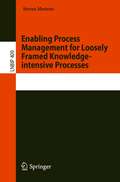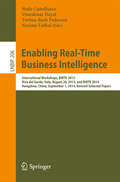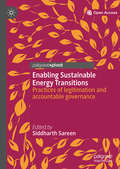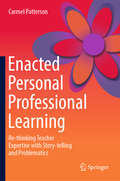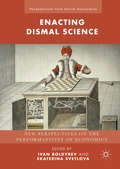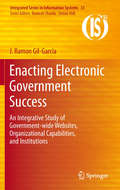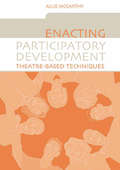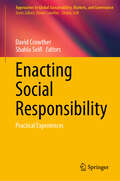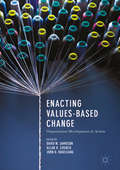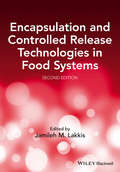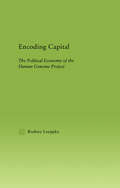- Table View
- List View
Enabling Immobilities: Social and Spatial Implications for Urban Planning (SpringerBriefs in Applied Sciences and Technology)
by Giovanni LanzaThis book presents a novel perspective on immobility, a topic often overlooked in urban planning and transport studies. It argues that conceptualizing, measuring, and analyzing the diverse forms in which individual immobilities manifest can provide crucial insights for designing more inclusive and sustainable planning policies. Immobility is here framed as a relative condition, where individuals experience reduced movement across time and space compared to others. While mobility is often seen as essential for social inclusion, this book challenges the notion that immobility is inherently negative. Instead, it positions immobility as not only the result of specific personal or spatial constraints but also as a reversible, voluntary choice to reduce daily travel. This choice can be influenced by the level of accessibility and proximity to valued spatial opportunities and can yield significant socio-environmental benefits. The book introduces an innovative framework that integrates immobility into urban planning theory and practice. Through case studies, it addresses four main operational challenges to foster a deeper understanding of immobility’s social and spatial implications: the measurement of immobility, the analysis of spatial conditions that facilitate chosen immobility, the exploration of the lived experiences of immobility, and the examination of planning policies that can promote reversible immobility to advance social inclusion and sustainability. By examining immobility in both its constrained and reversible forms, the book contributes to broader debates on how to achieve inclusion, sustainability, and accessibility through planning.
Enabling Process Management for Loosely Framed Knowledge-intensive Processes (Lecture Notes in Business Information Processing #409)
by Steven MertensThis book is a revised version of the PhD dissertation written by the author at the Department of Business Informatics and Operations Management at Ghent University in Belgium.It addresses shortcomings in Business Process Management concerning loosely framed knowledge-intensive processes, which are characterized by their numerous valid process variants and their reliance on knowledge workers to apply their knowledge to decide on a suitable process variant that fits the context of a specific process execution. The goal was to lay the foundation for a process-aware business process management (IT-)system to support such processes. Several proof-of-concept implementations have been made for the core components and were evaluated in the domain of the healthcare. Starting from an artificial, but realistic, case about patients that arrive in the emergency room with suspected arm fractures and later progressing to a case study of the diagnosis and treatment of patients in the emergency department of a real hospital, using data from their patient files. In 2020, the PhD dissertation won the “CAiSE PhD award”, granted to outstanding PhD theses in the field of Information Systems Engineering.
Enabling Real-Time Business Intelligence
by Malu Castellanos Umeshwar Dayal Torben Bach Pedersen Nesime TatbulThis book constitutes the thoroughly refereed conference proceedings of the 7th International Workshop on Business Intelligence for the Real-Time Enterprise, BIRTE 2013, held in Riva del Garda, Italy, in August 2013 and of the 8th International Workshop on Business Intelligence for the Real-Time Enterprise, BIRTE 2014, held in Hangzhou, China, in September 2014, in conjunction with VLDB 2013 and 2014, the International Conference on Very Large Data Bases. The BIRTE workshop series provides a forum for the discussion and advancement of the science and engineering enabling real-time business intelligence and the novel applications that build on these foundational techniques. This volume contains five full, two short, and two demo papers, which were carefully reviewed and selected with an acceptance rate of 45%. In addition, one keynote and three invited papers are included.
Enabling Sustainable Energy Transitions: Practices of legitimation and accountable governance
by Siddharth SareenThis open access book reframes sustainable energy transitions as being a matter of resolving accountability crises. It demonstrates how the empirical study of several practices of legitimation can analytically deconstruct energy transitions, and presents a typology of these practices to help determine whether energy transitions contribute to sustainability.The real-world challenge of climate change requires sustainable energy transitions. This presents a crisis of accountability legitimated through situated practices in a wide range of cases including: solar energy transitions in Portugal, urban energy transitions in Germany, forestland conflicts in Indonesia, urban carbon emission targets in Norway, transport electrification in the Nordic region, and biodiversity conservation and energy extraction in the USA. By synthesising these cases, chapters identify various dimensions wherein practices of legitimation construct specific accountability relations. This book deftly illustrates the value of an analytical approach focused on accountable governance to enable sustainable energy transitions. It will be of great use to both academics and practitioners working in the field of energy transitions.
Enabling Things to Talk
by Martin Bauer Alessandro Bassi Martin Fiedler Thorsten Kramp Rob Kranenburg Sebastian Lange Stefan MeissnerThe Internet of Things (IoT) is an emerging network superstructure that will connect physical resources and actual users. It will support an ecosystem of smart applications and services bringing hyper-connectivity to our society by using augmented and rich interfaces. Whereas in the beginning IoT referred to the advent of barcodes and Radio Frequency Identification (RFID), which helped to automate inventory, tracking and basic identification, today IoT is characterized by a dynamic trend toward connecting smart sensors, objects, devices, data and applications. The next step will be "cognitive IoT," facilitating object and data re-use across application domains and leveraging hyper-connectivity, interoperability solutions and semantically enriched information distribution. The Architectural Reference Model (ARM), presented in this book by the members of the IoT-A project team driving this harmonization effort, makes it possible to connect vertically closed systems, architectures and application areas so as to create open interoperable systems and integrated environments and platforms. It constitutes a foundation from which software companies can capitalize on the benefits of developing consumer-oriented platforms including hardware, software and services. The material is structured in two parts. Part A introduces the general concepts developed for and applied in the ARM. It is aimed at end users who want to use IoT technologies, managers interested in understanding the opportunities generated by these novel technologies, and system architects who are interested in an overview of the underlying basic models. It also includes several case studies to illustrate how the ARM has been used in real-life scenarios. Part B then addresses the topic at a more detailed technical level and is targeted at readers with a more scientific or technical background. It provides in-depth guidance on the ARM, including a detailed description of a process for generating concrete architectures, as well as reference manuals with guidelines on how to use the various models and perspectives presented to create a concrete architecture. Furthermore, best practices and tips on how system engineers can use the ARM to develop specific IoT architectures for dedicated IoT solutions are illustrated and exemplified in reverse mapping exercises of existing standards and platforms.
Enabling the Business of Agriculture 2017
by World Bank GroupEnabling the Business of Agriculture 2017, the third report in the series, offers insights into how laws and regulations affect private sector development for agribusinesses, including producer organizations and other agricultural entrepreneurs. Globally comparable data and scored indicators encourage regulations that ensure the safety and quality of agricultural inputs, goods and services but are not too costly or burdensome. The goal is to facilitate the operation of agribusinesses and allow them to thrive in a socially and environmentally responsible way, enabling them to provide essential agricultural inputs and services to farmers that could increase their productivity and profits. Regional, income-group and country-specific trends and data observations are presented for 62 countries and across 12 topics: seed, fertilizer, machinery, finance, markets, transport, water, ICT, land, livestock, environmental sustainability and gender. Data are current as of June 30, 2016. For more information, please see http://eba.worldbank.org
Enabling the Business of Agriculture 2019
by World BankEnabling the Business of Agriculture 2019 presents indicators that measure the laws, regulations and bureaucratic processes that affect farmers in 101 countries. The study covers eight thematic areas: supplying seed, registering fertilizer, securing water, registering machinery, sustaining livestock, protecting plant health, trading food and accessing finance. The report highlights global best performers and countries that made the most significant regulatory improvements in support of farmers.
Enabling the Internet of Value: How Blockchain Connects Global Businesses (Future of Business and Finance)
by Paolo Tasca Jiahua Xu Nikhil VadgamaThis book shows how blockchain technology can transform the Internet, connecting global businesses in disruptive ways. It offers a comprehensive and multi-faceted examination of the potential of distributed ledger technology (DLT) from a new perspective: as an enabler of the Internet of Value (IoV). The authors discuss applications of blockchain technology to the financial services domain, e.g. in real estate, insurance and the emerging Decentralised Finance (DeFi) movement. They also cover applications to the media and e-commerce domains. DLT’s impacts on the circular economy, marketplace, Internet of Things (IoT) and oracle business models are also investigated. In closing, the book provides outlooks on the evolution of DLT, as well as the systemic governance and privacy risks of the IoV. The book is intended for a broad readership, including students, researchers and industry practitioners.
Enacted Personal Professional Learning: Re-thinking Teacher Expertise with Story-telling and Problematics
by Carmel PattersonThis book offers a vital new approach to teacher professional learning, drawing on teachers’ stories from the field. It investigates expert teachers’ professional learning and uses a narrative framework to analyse their meaning-making processes. The book focuses on how proficient teachers develop their expertise, emphasising that individual needs and the contextual nature of learning require a personally enacted approach. Further, it explores the stories of five secondary school teachers, nominated by their colleagues for their outstanding expertise, to present new insights into expert teachers’ views. Using a new evidence-based approach, Enacted Personal Professional Learning, it incorporates teachers’ unique perspectives, problems and thought processes in order to understand expert teachers’ learning, and offers essential principles for promoting storytelling to help teachers be or become empowered educators who can actively shape education communities for teacher professional learning.
Enacting Dismal Science
by Ivan Boldyrev Ekaterina SvetlovaIn this book, sociologists, philosophers, and economists investigate the conceptual issues around the performativity of economics over a variety of disciplinary contexts and provide new case studies illuminating this phenomenon. In featuring the latest contributions to the performativity debate the book revives discussion of the fundamental questions: What precise meaning can we attribute to the notion of performativity? What empirical evidence can help us recognize economics as performative? And what consequences does performativity have for contemporary societies? The contributions demonstrate how performativity can serve as a powerful conceptual resource in dealing with economic knowledge, as an inspiring framework for investigating performative practices, and as an engine of discovery for thinking of the economic proper.
Enacting Electronic Government Success
by J. Ramon Gil-GarciaMany countries around the world are investing a great amount of resources in government IT initiatives. However, few of these projects achieve their stated goals and some of them are complete failures. Therefore, understanding e-government success has become very important and urgent in recent years. In order to develop relevant knowledge about this complex phenomenon, researchers and practitioners need to identify and assess what are the main conditions, variables, or factors that have an impact on e-government success. However, before being able to evaluate these impacts, it is necessary to define what e-government success is and what some e-government success measures are. This book presents a review of both e-government success measures and e-government success factors. It also provides empirical evidence from quantitative analysis and two in-depth case studies. Although based on sound theory and rigorous empirical analysis, the book not only significantly contributes to academic knowledge, but also includes some practical recommendations for government officials and public managers. Theoretically, the book proposes a way to quantitatively operationalize Fountain's enactment framework. Based on the institutional tradition, the technology enactment framework attempts to explain the effects of organizational forms and institutional arrangements on the information technology used by government agencies. According to Fountain (1995; 2001) the technology enactment framework pays attention to the relationships among information technology, organizations, embeddedness, and institutions. This framework is very well known in the e-government field, but is normally used for qualitative analysis and there is no previous proposal of how to use it with quantitative data. The book proposes variables to measure each of the different constructs in this framework and also tests the relationships hypothesized by Fountain's theory. Finally, using the advantages of the selected quantitative analysis technique (Partial Least Squares), the study also proposes some adjustments and extensions to the original framework in a theory building effort. Methodologically, the book reports on one of the first multi-method studies in the field of e-government in general and e-government success in particular. This study uses a nested research design, which combines statistical analysis with two in depth case studies. The study begins with a statistical analysis using organizational, institutional, and contextual factors as the independent variables. An overall score representing e-government success in terms of the functionality of state websites is the dependent variable. Second, based on the statistical results two cases are selected based on their relative fitness to the model (residuals) and their position in the general ranking of website functionality (which includes four different measures). In order to complement the results of the statistical analysis, case studies were developed for the two selected states (New York and Indiana), using semi-structured interviews and document analysis. In terms of the statistical analysis, the book constitutes one of the first applications of Partial Least Squares (PLS) to an e-government success study. PLS is a structural equations modeling (SEM) technique and, therefore, allows estimating the measurement model and the structural model simultaneously. The use of this sophisticated statistical strategy helped to test the relationships between e-government success and different factors influencing it, as well as some of the relationships between several of the factors, thus allowing exploring some indirect effects too.
Enacting Participatory Development: Theatre-based Techniques
by Julie MccarthyTheatre can play an essential role in addressing issues of power in social, political and cultural relationships, and acting as a catalyst for personal and societal change. This comprehensive and lively sourcebook advocates the use of theatre in participatory development as a way for groups to discover their own goals and aspirations, and to develop strategies for improving their lives based on need and experience. The first part presents 140 exercises designed to be used at all stages of participatory workshops ranging from initial ice-breakers and warm ups to exercises dealing with conflict resolution, power relations, issue-based work and project evaluation. Each exercise is explained in an easy-to-follow format and is followed by commentaries from experienced field practitioners. The second part contextualises theatre for development practice within current debates on empowerment and participation, and presents case studies illustrating the diverse contexts in which theatre for development can be used.
Enacting Regional Dynamics and Entrepreneurship: Bridging The Territorial And Functional Rationales
by Bengt Johannisson Åsa Lindholm DahlstrandIn present digital times the focus is on globalization and the dynamics and complexities that it creates. However, in spite of being dominated by technology the world remains populated by human beings practising a localized everyday life. This contrast should challenge every researcher who is concerned with business and societal development and how that is contingent upon the institutional and cultural (national) context. In this book, Swedish researchers reflect upon entrepreneurship as a possible mediator between local and global economic and social concerns. Using as a point of departure the tensions between a functional, footloose rationale and a territorial rationale tied to place, the authors provide different aspects on regional development in a globalised world. A shared concern is the importance of recognizing the many appearances of entrepreneurship that brings it beyond being an innovative force in the market. The book thus presents different strategies and tactics for pursuing localized economic development and it also critically reviews adopted public support programmes and measures of the (local) business climate. The conclusive message is that only by bridging the functional and territorial views will it be possible to sustain, and possibly enhance, economic and social life in local places as well as in our shared world. This book was originally published as a special issue of European Planning Studies.
Enacting Social Responsibility: Practical Experiences (Approaches to Global Sustainability, Markets, and Governance)
by David Crowther Shahla SeifiThis book explores the pervasive nature of socially responsible behavior, which has evolved beyond Corporate Social Responsibility (CSR) to become an integral part of all organizational activities and investments. It presents how socially responsible decision-making is now embedded within the core operations of organizations globally. Despite the widespread recognition of its importance, there remains a significant gap in understanding the practical effects of such behavior. This book aims to bridge that gap by providing a comprehensive analysis of the real-world impacts of social responsibility. Taking a global perspective, the book investigates the practical outcomes of socially responsible actions across various countries and sectors. It explores how organizations worldwide implement and benefit from these practices, offering a rich tapestry of observations and insights. By examining a diverse range of fields, the book presents a holistic view of the effects of socially responsible behavior, highlighting both successes and challenges. Through its detailed analysis and global scope, this book offers valuable contributions to the ongoing discourse on social responsibility. It provides readers with a deeper understanding of how socially responsible practices are applied in different contexts and their tangible impacts. Whether you are a scholar, practitioner, or policymaker, this book serves as an essential resource for anyone interested in the practical implications of social responsibility in today’s interconnected world.
Enacting Values-Based Change
by Allan H. Church David W. Jamieson John D. VogelsangThis edited volume highlights the use and practice of values in Organization Development (OD). It addresses how those values have changed over time, how they are expressed in OD’s approach to consulting, the process of making value-based decisions, and how to deal with value dilemmas and value conflicts. OD scholars and practitioners will learn about the balance of values in practice, particularly as the business outcomes may overtake positive humanistic concerns given intense pressures to enhance organizational productivity year over year.
Encapsulation And Controlled Release Technologies In Food Systems
by Jamileh M. LakkisSince the launch of the first edition, several new encapsulation technologies have been introduced while older technologies have found newer applications in food systems. The main goal of this new edition is to expand on the information presented in the first edition and to bring to light new innovations in microencapsulation technologies and their impact on the food and health ingredients sector. As with the first edition, this book will be organized in chapters which focus on specific applications. Four new chapters will be added while existing chapters will be updated to reflect advances in the technologies presented.
Enchanted Objects: Innovation, Design, and the Future of Technology
by David RoseIn the tradition of Who Owns the Future, an MIT Media Lab scientist imagines how everyday objects can intuit our needs, improve our lives, and form “an ethereal interconnection of gadgets and human desires that...will pervade our lives in the very near future” (The Wall Street Journal).We are now standing at the precipice of the next transformative development, a world in which technology becomes more human. Soon, connected technology will be embedded in hundreds of everyday objects we already use: our cars, wallets, watches, umbrellas, even our trash cans. These objects will respond to our needs, come to know us, and even learn to think ahead on our behalf. David Rose calls these devices—which are just beginning to creep into the marketplace—Enchanted Objects. In Rose’s vision of the future, technology atomizes, combining itself with the objects that make up the very fabric of daily living. Such innovations will be woven into the background of our environment, enhancing human relationships, channeling desires for omniscience, long life, and creative expression. The enchanted objects of fairy tales and science fiction will enter real life. Groundbreaking, timely, and provocative, Enchanted Objects is a “delightful” (The New York Times) blueprint for a better future, where efficient solutions come hand in hand with technology that delights our senses. It is essential reading for designers, technologists, entrepreneurs, business leaders, and anyone who wishes to take a glimpse into the future.
Enchantment
by Guy KawasakiEnchantment, as defined by bestselling business guru Guy Kawasaki, is not about manipulating people. It transforms situations and relationships. It converts hostility into civility and civility into affinity. It changes the skeptics and cynics into the believers and the undecided into the loyal. Enchantment can happen during a retail transaction, a high-level corporate negotiation, or a Facebook update. And when done right, it's more powerful than traditional persuasion, influence, or marketing techniques.Kawasaki argues that in business and personal interactions, your goal is not merely to get what you want but to bring about a voluntary, enduring, and delightful change in other people. By enlisting their own goals and desires, by being likable and trustworthy, and by framing a cause that others can embrace, you can change hearts, minds, and actions. For instance, enchantment is what enabled . . .A Peace Corps volunteer to finesse a potentially violent confrontation with armed guerrillas.A small cable channel (E!) to win the TV broadcast rights to radio superstar Howard Stern.??A seemingly crazy new running shoe (Vibram Five Fingers) to methodically build a passionate customer base.??A Canadian crystal maker (Nova Scotian Crystal) to turn observers into buyers.This book explains all the tactics you need to prepare and launch an enchantment campaign; to get the most from both push and pull technologies; and to enchant your customers, your employees, and even your boss. It shows how enchantment can turn difficult decisions your way, at times when intangibles mean more than hard facts. It will help you overcome other people's entrenched habits and defy the not-always-wise "wisdom of the crowd."Kawasaki's lessons are drawn from his tenure at one of the most enchanting organizations of all time, Apple, as well as his decades of experience as an entrepreneur and venture capitalist. There are few people in the world more qualified to teach you how to enchant people.As Kawasaki writes, "Want to change the world? Change caterpillars into butterflies? This takes more than run-of-the-mill relationships. You need to convince people to dream the same dream that you do." That's a big goal, but one that's possible for all of us.
Enchantment: The Art of Changing Hearts, Minds, and Actions
by Guy KawasakiEnchantment, as defined by bestselling business guru Guy Kawasaki, is not about manipulating people. It transforms situations and relationships. It converts hostility into civility and civility into affinity. It changes the skeptics and cynics into the believers and the undecided into the loyal. Enchantment can happen during a retail transaction, a high-level corporate negotiation, or a Facebook update. And when done right, it's more powerful than traditional persuasion, influence, or marketing techniques. Kawasaki argues that in business and personal interactions, your goal is not merely to get what you want but to bring about a voluntary, enduring, and delightful change in other people. By enlisting their own goals and desires, by being likable and trustworthy, and by framing a cause that others can embrace, you can change hearts, minds, and actions. For instance, enchantment is what enabled . . . A Peace Corps volunteer to finesse a potentially violent confrontation with armed guerrillas. A small cable channel (E!) to win the TV broadcast rights to radio superstar Howard Stern. ?? A seemingly crazy new running shoe (Vibram Five Fingers) to methodically build a passionate customer base. ?? A Canadian crystal maker (Nova Scotian Crystal) to turn observers into buyers. This book explains all the tactics you need to prepare and launch an enchantment campaign; to get the most from both push and pull technologies; and to enchant your customers, your employees, and even your boss. It shows how enchantment can turn difficult decisions your way, at times when intangibles mean more than hard facts. It will help you overcome other people's entrenched habits and defy the not-always-wise "wisdom of the crowd. " Kawasaki's lessons are drawn from his tenure at one of the most enchanting organizations of all time, Apple, as well as his decades of experience as an entrepreneur and venture capitalist. There are few people in the world more qualified to teach you how to enchant people. As Kawasaki writes, "Want to change the world? Change caterpillars into butterflies? This takes more than run-of-the-mill relationships. You need to convince people to dream the same dream that you do. " That's a big goal, but one that's possible for all of us. .
Enclaves of Exception: Special Economic Zones and Extractive Practices in Nigeria
by Omolade AdunbiHow do we measure and truly grasp the sweeping social and environmental effects of an oil-based economy? Focusing on the special economic zones resulting from China's trading partnership with Nigeria, Enclaves of Exception offers a new approach to exploring the relationship between oil and technologies of extraction and their interrelatedness to local livelihoods and environmental practices. In this groundbreaking work, Omolade Adunbi argues that even though the exploitation of oil resources is dominated by big corporations, it establishes opportunities for many former Nigerian insurgents and their local communities to contest the ownership of such resources in the oil-rich Niger Delta and to extract oil themselves and sell it.Based on extensive ethnographic fieldwork, Enclaves of Exception makes clear that, although both the free trade zones and the now booming local artisanal refineries share the goals of profit-making and are enthusiastically supported by those benefiting from them economically, they have yielded dramatically the same environmental outcome for communities around them that included pollution with precarious effects on the health of the populations in the regions, and displacement of population from their livelihood practices.
Encoding Capital: The Political Economy of the Human Genome Project (New Political Economy)
by Rodney LoeppkyFirst Published in 2005. Routledge is an imprint of Taylor & Francis, an informa company.
Encompassing: Practical Applications Through Simulation
by Robert C. Marshall Jean-Francois Richard Chaohai ShenAn operational simulation-based implementation of a fundamental research principle in the sciences—the idea that a model must account for, or encompass, findings of alternative models.To account for the universal deficiency of all economic models, Jean-François Richard, Robert Marshall, and Chaohai Shen propose in this book an operational test of whether a model accounts for—or encompasses—key results of alternative models. This simulation-based approach is distinct from the likelihood-based approach of forty-plus years ago. It is specifically designed to be applicable to serious nonlinear applications, under the minimal requirement that the models under consideration be amenable to Monte Carlo simulations.The method of simulated moments, increasingly applied in major empirical applications, provides the ideal framework to compute a wide range of formal simulation-based encompassing test statistics. The authors argue that simulation-based encompassing is particularly easy to implement when the model of interest incorporates novel features relative to an earlier &“benchmark&” model: that is, &“nests&” the latter.The book should be of particular interest to practitioners, researchers, and graduate students who wish to validate their models using simulation-based encompassing as a rigorous scientific alternative to more informal model comparisons.
Encore: Finding Work that Matters in the Second Half of Life
by Marc FreedmanIn one of the most significant social trends of the new century, and the biggest transformation of the American workforce since the women's movement, members of the baby boom generation are inventing a new phase of work. Encore tells the stories of encore career pioneers who are not content, or affluent enough, to spend their next thirty years on a golf course. These men and women are moving beyond midlife careers yet refusing to phase out or fade away. As they search for a calling in the second half of life and focus on what matters most, these individuals stand to transform the nature of work in America. They also hold the potential to create a society that balances the joys and responsibilities of contribution across the generations-in other words, one that works better for all of us.
Encountering Development: The Making and Unmaking of the Third World (Princeton Studies In Culture/power/history Ser. #1)
by Arturo EscobarHow did the industrialized nations of North America and Europe come to be seen as the appropriate models for post-World War II societies in Asia, Africa, and Latin America? How did the postwar discourse on development actually create the so-called Third World? And what will happen when development ideology collapses? To answer these questions, Arturo Escobar shows how development policies became mechanisms of control that were just as pervasive and effective as their colonial counterparts. The development apparatus generated categories powerful enough to shape the thinking even of its occasional critics while poverty and hunger became widespread. "Development" was not even partially "deconstructed" until the 1980s, when new tools for analyzing the representation of social reality were applied to specific "Third World" cases. Here Escobar deploys these new techniques in a provocative analysis of development discourse and practice in general, concluding with a discussion of alternative visions for a postdevelopment era. Escobar emphasizes the role of economists in development discourse--his case study of Colombia demonstrates that the economization of food resulted in ambitious plans, and more hunger. To depict the production of knowledge and power in other development fields, the author shows how peasants, women, and nature became objects of knowledge and targets of power under the "gaze of experts." In a substantial new introduction, Escobar reviews debates on globalization and postdevelopment since the book's original publication in 1995 and argues that the concept of postdevelopment needs to be redefined to meet today's significantly new conditions. He then calls for the development of a field of "pluriversal studies," which he illustrates with examples from recent Latin American movements.

